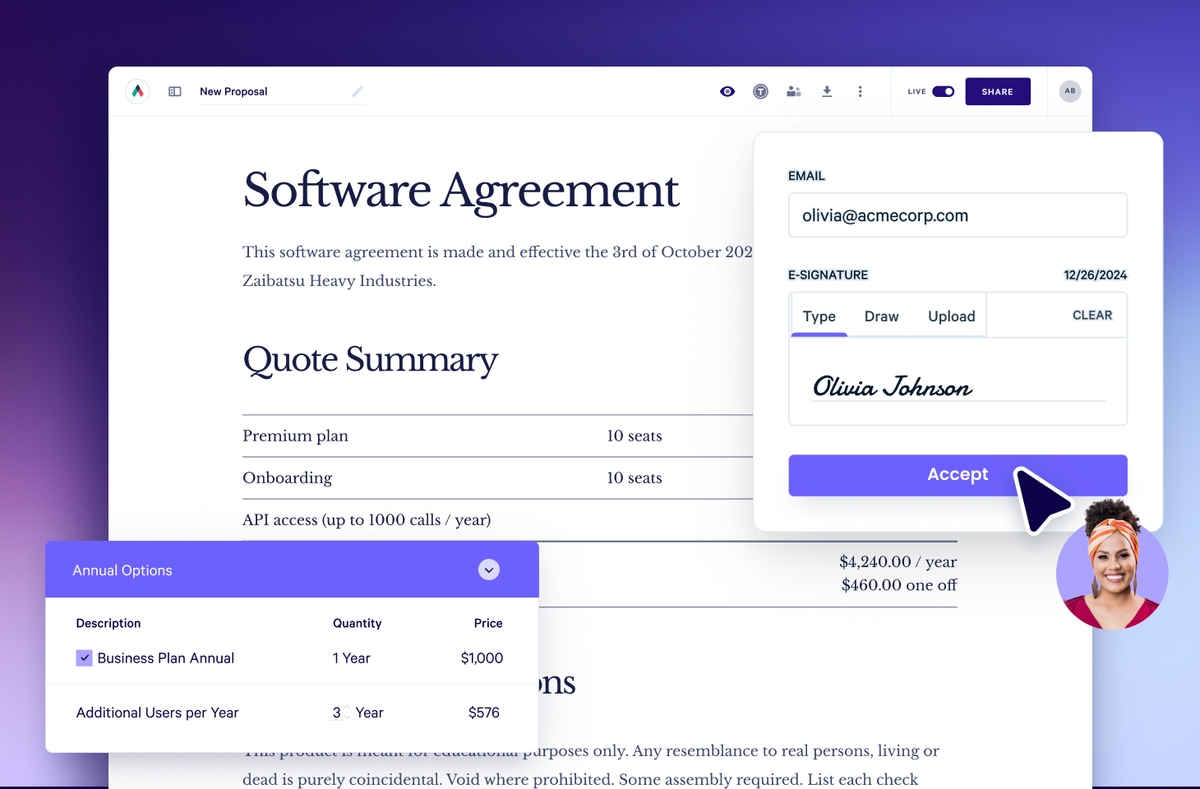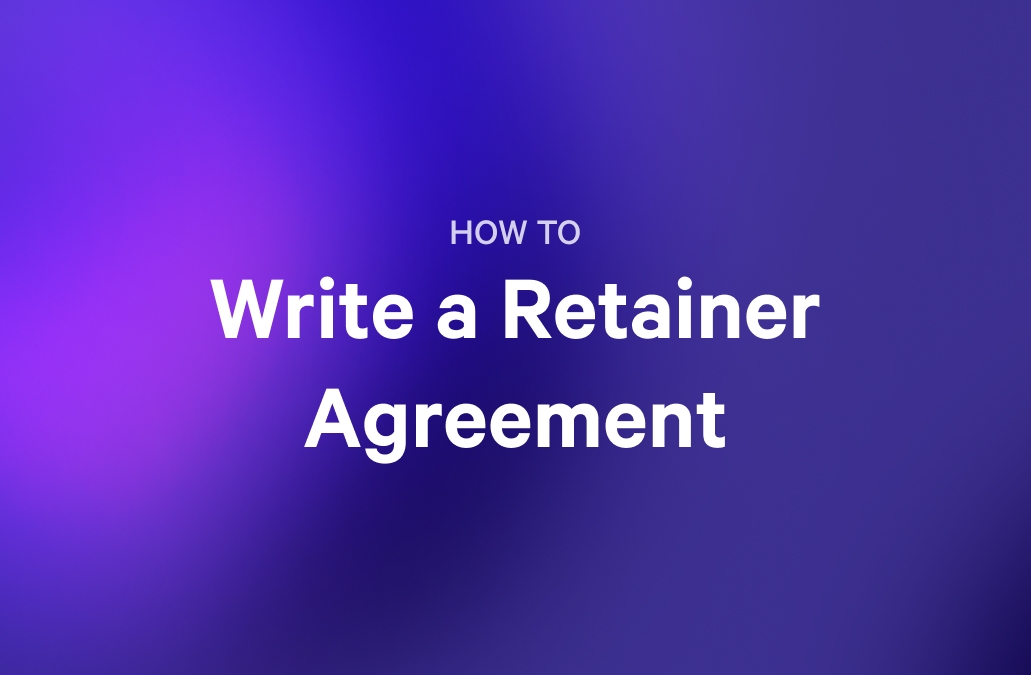I used to think getting a "yes" meant the deal was done.
Back then, I'd celebrate too early, only to watch some prospects ghost, stall, or come back with confusing legal redlines I didn't know how to handle. I'd worked hard to build trust, pitch the value, and answer every objection.
But the final step? That's where things quietly slipped.
While you're mentally banking the commission, prospects are scrutinizing terms, running things by legal, or simply getting cold feet.
Since then, I've learned how to treat the contract signing process as part of the sale and not as an afterthought. In this guide, I'll explain what contract signing means in sales and how to handle online contracts without fumbling the finish line.
Key takeaways
- A verbal “yes” doesn’t close the deal—only a signed contract makes it official.
- Preparing your contract based on real client conversations reduces delays and revisions.
- Always confirm who has legal authority to sign before sending the agreement.
- Electronic signatures are legally valid in most regions and help contracts close faster.
- Platforms like Qwilr streamline the entire contract lifecycle—from drafting to storing the final copy.
What is contract signing?
Contract signing is the formal agreement between two parties to move forward on the terms you've discussed, usually after a verbal yes or handshake deal.
Sales contracts lock in both sides' scope, pricing, responsibilities, timelines, and legal protections. You may have alignment in principle, but you're exposed to last-minute changes, scope creep, or walkaways without a signed agreement.
Depending on your business, this moment can look very different.
For example, I send a simple services agreement through Qwilr outlining deliverables and payment terms. On the other hand, a SaaS sales rep might route a master services agreement (MSA) and order form for internal approval and the other party's signature.
When both parties agree, the agreement becomes active as of the execution date—the date the contract is considered legally binding, even if the work starts later.
Types of contract signatures
Depending on your industry, client preferences, and local laws, the way involved parties sign online contracts can impact both speed and legal enforceability. Here are the most common types to know:
- Electronic signatures (eSignatures): The most widely used today, especially in remote sales. These are legally enforceable in most countries and include audit trails, time stamps, and IP tracking. In the U.S., for example, e-signatures are governed by the ESIGN Act and the Uniform Electronic Transactions Act (UETA), which recognize them as legally valid. The EU follows the eIDAS Regulation, which sets similar standards for digital signatures.
- Wet signatures: This is the old-school pen-on-paper method. Some clients—especially larger enterprises or those in regulated industries—may still require this. It's slower, but it can carry more weight in certain legal systems. Many organizations still need an original signed copy for their document management system.
- Typed name with checkbox consent: Occasionally used in low-risk agreements or fast sign-ups. While convenient, this method may not hold up in every legal context. It's best reserved for internal approvals, purchase orders, or agreements with minimal liability.
When in doubt, digital signatures strike the best balance between speed, professionalism, and legal coverage.
How do you prepare for contract signing?
Deals often stall at the finish line because of vague terms, missing approvers, or legal friction that could’ve been handled earlier.
Prep for the contract signing process by aligning early on deal terms, understanding who needs to approve what, and preempting common objections.

That way, when digital contracts hit their inbox, it's just a signature and not a negotiation.
Prepare your draft
When writing your contract, start with your company's approved templates, but view them as starting points, not finished products.
Gather all verbal agreements and email trails documenting what you've promised the client. When the draft matches what's already been discussed, it shortens the review cycle and minimizes back-and-forth with legal or procurement.
Match each commitment to a specific contract section. Are all deliverables, timelines, and payment terms clearly represented?
Note any unique requirements discussed during negotiations that may need custom language.
Clarity prevents disputes. Vague terms that seem flexible during sales can become contentious when implementation begins.
Review the draft
Before sending any contract to a client, review it yourself. I made the costly mistake of sending a template with another client's name still embedded in it—not exactly the professional impression you want to make when closing a deal worth thousands.
Start by checking:
- Are all involved parties correctly named and identified?
- Do the scope, deliverables, and timeline match what you discussed?
- Are payment terms and amounts consistent with your proposal?
- Have you removed all references to previous clients?
Loop in your legal team early, not as the final step before sending. What seems like a minor change to you ("Let's just adjust the payment schedule slightly") might have significant legal implications.
I've found that setting context for the legal team about the client's importance and any competitive pressures helps them understand when flexibility might be warranted. Don't just email them the contract with "please review"—have a conversation about what's at stake and any concerns specific to this client.
Finalizing the draft
Before signature day, align on details with your client through a preview conversation. Walk them through key sections, explaining obligations and timelines without legal jargon.
This preparation step prevents last-minute objections that can delay closing. Listen carefully for hesitation in their voice since it might signal unaddressed concerns.
For example, a CMO once said, "The payment terms look... fine." I noticed the pause and asked a follow-up question and learned about their cash flow timing concerns that would have derailed the signing.
Summarize any requested changes clearly and set expectations about what you can modify versus what's standard policy. Transparency builds trust and momentum toward signing day.
3 steps to signing a contract
Once the draft is ready, your job shifts from preparation to execution.
This part is about getting the right signatures, using a method that makes sense for your client, and making sure the final agreement is complete, compliant, and ready to hold up under scrutiny.
1. Identify the authorized signatories
Confirm who can legally bind the organization—typically C-suite executives, directors, or designated representatives with documented signing authority.
For larger companies, check their delegation of authority policy, which outlines who can sign for specific contract values.
In my work, I often discuss project details with Content Marketing Managers, but contracts usually require Director of Content or VP of Marketing signatures. One client's CMM confidently assured me she could sign, only for legal to later reject the contract, which delayed our project start by three weeks.
Here's what this often looks like for me:

Note how the contract includes:
- Date the agreement begins
- Full legal business names
- Types of entities
- Addresses (or principal places of business)
- Shortened names or abbreviations
Pro tip: When working with international clients, verify if multiple signatures are required under local laws.

Qwilr makes it easy to collect multiple signatures on one document
2. Choose the right signing method
There are two main ways to sign contracts: the traditional physical route or the faster, more common digital route. What you choose depends on your client’s preferences, legal requirements, and how formal the agreement needs to be.
Physical Signing (Traditional Method)
Physical signing involves printing, signing by hand, scanning, and emailing the document back. It’s still common in highly regulated industries or when legal teams specifically request it.
It works well for local clients or when a ceremonial signing matters. Print multiple copies (one for each party), use blue ink to separate originals from copies, and have signatories initial each page to prevent page substitution.
That said, it can slow down the process and introduce room for error—missed signatures, outdated versions, or long email threads.
Electronic Signing (E-Signatures)
Digital signatures let you sign online contracts that your buyer can review and sign in minutes, from any device.
Online contracts with e-signatures offer several benefits: they're 3.3 times more likely to close and close 30% faster. Digital contracts speed up the close, reduce drop-off, and give both sides a professional, trackable paper trail.
E-signature software like Qwilr makes it easy to send professional-looking proposals and create electronic signatures in just a few clicks. Upload your finalized contract to Qwilr or create it directly in the platform.

In the left search box of your Qwilr editor, add and turn on the “Accept + Sign” option. This lets you add a signature block directly to the page.

You can set up a page for multiple people to e-sign it. Qwilr allows you to have as many signers as you'd like, but note that your contract won't be accepted until all signers have signed it.
Click the + icon or enter the number into the menu to add multiple signers. The same number of signer icons will appear below the Accept button.

You can also add the names of your signers to the e-signature menu. This way, your clients will know who needs to sign and what signatures are pending.

Once your page is ready, sign your end of the contract if needed and send the live Qwilr link directly to your client. You'll get a real-time notification when your client views and signs the contract.
3. Exchange the signed contracts
Signed documents are stored in Qwilr automatically, so you can refer to them anytime.
Once everyone signs, you can access the Audit Trail, which contains all signatures, and the date and time of each one. Each signer receives an email containing a link to the PDF copy of the signed page.

If you're signing manually, send a scanned PDF to the client and save a version on your end, too. This final step confirms mutual agreement and gives both sides a reference point if questions or issues pop up later.
Simplify contract signing with Qwilr
Smooth contract signing keeps the momentum high. With e-signatures and smart contract management, you can reduce friction, speed up approvals, and close deals with confidence.
A trusted platform like Qwilr tracks every step from the first draft to the final signature, so contracts are sent, signed, and stored without delays or confusion. Try it free and see how Qwilr simplifies contract workflows.
About the author

Kiran Shahid|Content Marketing Strategist
Kiran is a content marketing strategist with over nine years of experience creating research-driven content for B2B SaaS companies like HubSpot, Sprout Social, and Zapier. Her expertise in SEO, in-depth research, and data analysis allow her to create thought leadership for topics like AI, sales, productivity, content marketing, and ecommerce. When not writing, you can find her trying new foods and booking her next travel adventure."


